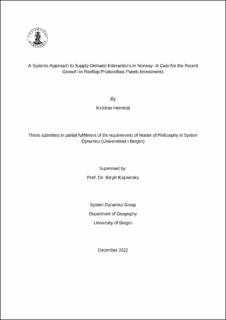A Systems Approach to Supply-Demand Interactions in Norway: A Case for the Recent Growth in Rooftop Photovoltaic Panels Investments
Master thesis
Permanent lenke
https://hdl.handle.net/11250/3050513Utgivelsesdato
2023-02-02Metadata
Vis full innførselSamlinger
- Master theses [140]
Sammendrag
Adoption of solar panels in Norway has been driven by various factors ranging from the economic benefit from adoption, motivation for self-sufficiency, knowledge of the performance of PV and the perceived environmental performance. This has been widely reported in academic literature and confirmed in observations of non-adopter, potential adopters and adopters in comment sections in social media. Yet, the adoption of solar panels is currently constrained by the supply-side of solar panels. The limited availability of solar panels due to supply chain issues and the availability of skilled installers have reported to constrain adoption. Using system dynamics modelling, two policies have been tested in order to address these constraints: a hiring policy and an inventory policy, consisting of recycling and reusing solar panels. The results of these policies conveys that the hiring policy is not useful in the BAU scenario, because there are too few solar panels. However, if the production rate of the producers is more like the desired shipment to Norway, then a hiring policy is more impactful. Overall, the inventory policies were more effective in increasing adoption of solar panels. In the end, the most important insight is that it is not beneficial use of resources of demand-side policies if the capacity of the suppliers is too low. For increased adoption rate, the policies must be on the supply-side.
